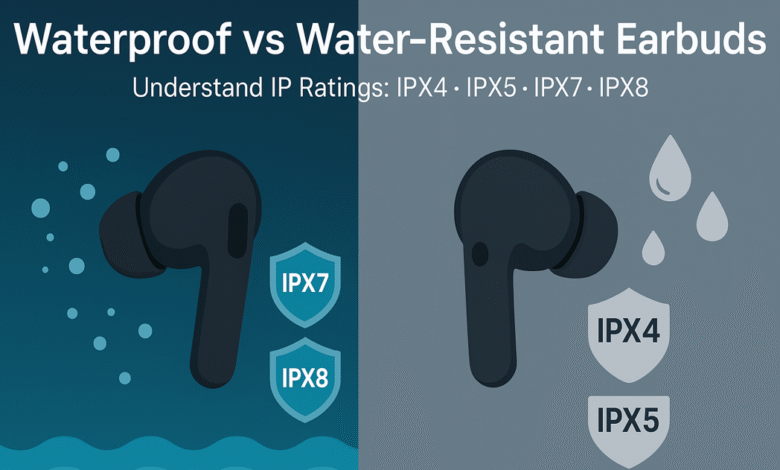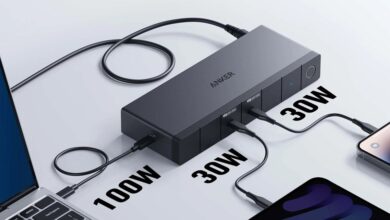Waterproof Earbuds vs Water Resistant Earbuds: What’s the Real Difference?

Wireless audio has transformed the way we listen to music, work out and travel. But with earbuds becoming our everyday buddies (and surviving the rain and sweat, along with coming out of showers unscathed), one question remains steadfast: what’s the difference between waterproof and water resistant earbuds?
On the surface, these terms sound interchangeable but they’re not. In truth, knowing the difference could mean having a pair of earbuds to last you a few years versus something that falls apart after your first sweaty gym sesh. Let’s delve into what waterproof really means in this domain, how the ever-confusing IP ratings system works and which type of earbuds might be right for you.
Understanding the Fundamentals: What Makes Earbuds Waterproof or Water Resistant?
Waterproof and water resistant earbuds are both made to fend off moisture, but the level of protection they offer is not even in the same realm.
When a pair of earbuds claims water resistance, it means the device can withstand light moisture that comes its way, think sweat, drizzle or an accidental splash and remain unscathed. Waterproof earbuds, meanwhile, have full submersion in mind, withstanding deeper and longer-lasting submergence.
This discrepancy all boils down to IP rating, the international standard that quantifies how protected a device is from solids and liquids. The rating has two numbers: for example, IPX4 or IP68 and the second number describes water resistance.
Understanding IP Ratings: The Story Behind Those Numbers
If you’ve ever read product descriptions for earbuds, you probably have seen codes like IPX5, or IPX7 or more recently, the higher sounding figure of IP68. These are not arbitrary, they’re specific engineering standards.
The earbuds are IPX4, so they can withstand light splashes and sweat.
IPX5 or IPX6 will withstand low-pressure water jets, rain or rinsing off under a tap.
IPX7 or IPX8 in fact signifies how the earbuds can withstand submersion typically for 30 minutes of being under a meter deep (IPX7), or even more so when rated as IPX8.
So, if you’re going to use your earbuds for running or gym workouts, models rated IPX4 or IPX5 are generally fine. But if you’re swimming, kayaking or wearing them in heavy rain, you need at least IPX7 or IPX8 waterproof earbuds.
Waterproof Earbuds: Designed to Be Immersed in Water Up to 1 m for 30 Minutes
One thing to add though: Waterproof earbuds are really meant to do more than just take a bit of sweat. They’re constructed with sealed casings, hydrophobic nano-coatings and tight rubber gaskets to keep out external moisture from the internal circuits.
Many swimming headphones are waterproof and feature internal storage for playing music because your Bluetooth signal won’t travel far in water. Products such as the Sony NW-WS413 or H2O Audio Tri Pro are designed especially for underwater listening.
Real-World Example
If you have ever accidentally dropped your earbuds in a pool, you understand the importance of waterproofing. Though budget earbuds might short-circuit on impact, high-end waterproof ones can survive quick dunks, showers, or open-water swimming without missing a beat.
From a user perspective, they are practically indestructible, ideal for triathletes, surfers and anyone who doesn’t want to predict the weather forecast.
Water Resistant Earbuds: Our Everyday, Always-On Protection
Waterproof earbuds, on the other hand, are more suitable for basic protection against everyday life; rainy commutes to and from work, sweaty workouts at the gym or just moving through a humid climate. They are not designed to survive underwater, but they balance comfort, a light build and moderate protection from moisture.
These earbuds are generally rated IPX4 or IPX5, which means they’re perfect for jogging in the rain, hitting the gym and getting super sweaty (gross), biking, bouncing around on the subway or sitting at your desk in s, so it’s easy to find a pair that will work just as hard as you. They typically include the Apple AirPods Pro (IPX4) and the Samsung Galaxy Buds 2 Pro (IPX7), but while each of these has a high enough rating to repel sweat and splash, they shouldn’t be submerged.
If you’ve ever completed a run in the rain or rinsed waterlogged earbuds under a tap, their water resistance has come to your rescue. Just be careful not to wear them in the shower or while swimming.
Waterproof vs Water Resistant Earbuds: Differences That Matter
| Feature | Waterproof Earbuds | Water Resistant Earbuds |
| Protection level | Immersion in water surviving | Splashes and sweat resistant |
| Typical IP Rating | IPX7 or higher | IPX4–IPX6 |
| The best use case would be | Swimming, heavy rain, outdoor activities | Gym workouts, light rain, daily commute |
| Prices | Higher than average due to better sealing | Moderate to low; dependent on size and design |
| Battery and Design | May use larger seals and provide less roomier fit | Light weight, ergonomic in design & breathable |
When deciding between them, consider your environment and how you tend to vape. If you stay mostly inside or only encounter occasional light moisture, moisture resistant earbuds are your best fit. But if you spend a lot of your time in the water, travel, or have a job as an outdoor athlete, waterproofing is worth every penny.
Sound Quality and Longevity: How Does Waterproofing Impact Sound Quality?
One of the widespread beliefs about waterproofing is that it comes at the expense of sound quality but that’s mostly a thing of the past. Modern waterproof earbuds rely on state of the art acoustic membranes and pressure-equalizing vents to ensure that the clear sound is uninterrupted by water.
However, the build materials and fit of headphones can affect how a driver moves sound around underwater or in a workout. Closed designs are often employed for waterproof earbuds, as a way to seal the water out; these can improve bass but can cause highs to sound a bit muffled. Open earbuds, like many that are water resistant, can tend to feel airier and more natural for your everyday listening.
When it comes to durability, waterproof earbuds are likely to last longer if you trash gear around, but they also require the appropriate drying and care to avoid corrosion in their charging ports.
How to Select the Perfect Pair: Find Your Lifestyle
For Fitness Enthusiasts
If you exercise or run every day, then it’s all about sweat resistance. Seek out IPX5 earbuds with enough water resistance to keep your sweat at bay while still providing a secure fit and lightweight comfort. Some models also sport ear hooks or silicone wings to help them stay on during high-motion workout activities.
For Swimmers and Outdoor Adventurers
Better to shoot directly for IPX7 or IPX8 water-resistant earbuds. Choose one of those that have onboard storage, since Bluetooth does not work well when you’re underwater. Please check the compatibility of your device before purchasing.
For Commuters and Casual Listeners
If you’re worried about a surprise drizzle or the weather being too muggy, then water resistant earbuds are just fine. They offer sturdy protection without the bulk and weight.
For Professionals and Students
Waterproof earbuds are great for multitasking, with calls, meetings and online classes on the go while giving you confidence against spills or rain.
Frequent Misconceptions About Waterproof and Water-Resistant Earbuds
Myth 1: Any earbuds with an IP rating are suitable for swimming.
Not true. Full submersion is supported only with pools that specs say are explicitly designed for running systems under water. IPX7 can handle brief submersion, serial swimming will still ruin them.
Myth 2: The waterproof earbuds are invincible.
Even the toughest earbuds can wear down after exposure to saltwater, chlorine or heat. And always rinse and dry them well after they’re exposed to water.
Myth 3: The higher the IP rating, the better the sound.
IP ratings simply signify protection level, rather than the sound quality. A lot of IPX4 earbuds even wind up sounding clearer and deeper in the bass than IPX8 models.
Myth 4: You can charge your earbuds when they are wet.
Never do this. Waterproof models will even need an absolutely dry charging port to prevent short-circuiting.
Maintenance Tips to Extend Lifespan
Here’s what most people overlook:
- Always dry earbuds before charging.
- If you’ve worn them in salt or chlorine, give’em a rinse with fresh water and then pat them dry.
- Don’t leave them in the steamy environment of a bathroom or a gym locker.
- Do not let the charging case get wet or dirty.
Executing this process will keep your investment in good shape and maintain optimal performance, even on the tough worksite.
The Evolution of Waterproofing Technology
The path from early splash-proof designs to the wondrous waterproofed earbuds we have today is quite a journey. Earlier designs often fell short with regards to seal integrity and sound quality, but today’s technologies have resulted in solutions that allow the ingress of water through special nanocoatings, hydrophobic layers, or intelligent venting without affecting the purity of sound.
Now, brands such as Sony, JBL and Jabra have poured resources into this technology, creating earbuds that can withstand anything from a heavy rain shower to the conditions of an Ironman race and still deliver noise cancellation, touch controls and deep bass.
That shift illustrates how the industry is reacting to what people really need and want, not just better sound, but reliability wherever life takes you.
Personal Take: What I Discovered Testing Both Ways
But after trying dozens of models from budget water resistant earbuds to top-of-the-line waterproof ones I discovered there’s no universal solution.
On your daily commute, or if you’re working out, it’s water-resistant earbuds such as the AirPods Pro or Jabra Elite 4 Active that make more sense and feel right to wear for hours at a time because they are light and airy. But on a recent trip to the beach, only my set of IPX8-rated waterproof buds emerged unscathed from saltwater splashes and direct sun assault.
The lesson? It’s not just about finding the most durable earbuds but matching protection levels to fit your lifestyle.
Bottom Line: The Wise Decision
When you’re in the market for new earbuds, don’t be swept up by marketing buzzwords. Know what the IP rating means, consider how you use devices and buy based on actual need instead of whatever has the highest number.
For the swimmers, outdoor adventurers, and those who want complete peace of mind, waterproof earbuds are the best protection. Water resisting earbuds, on the other hand, are wonderful all-arounders light and comfortable enough to wear every day.
So make it simple: waterproof to swim, water resistant for protection and you’ll never have to worry what the rain’s done to your playlist.
FAQs
What is the primary difference between waterproof and water resistant earbuds?
Waterproof earbuds are designed to be fully submerged, while water resistant earbuds simply provide some splash, sweat or rain protection.
Is it safe to swim with waterproof earbuds?
Only with models specifically made for swimming, and often rated IPX7 or IPX8 and offering internal storage for music.
Are waterproof earbuds worth the extra money?
Yes, if you are spending a significant amount of time in the sun or water, or are traveling in wild-card weather. Water resistant is enough for general use.
Are IPX rated products foolproof for this kind of protection?
Not always. IP ratings quantify lab-tested resistance, but real-world elements like salt, pressure and temperature can influence performance.
Which is more durable: waterproof or water resistant earbuds?
A well-kept set of waterproof earbuds will last longer, but good workmanship and how you treat them are just as vital.



